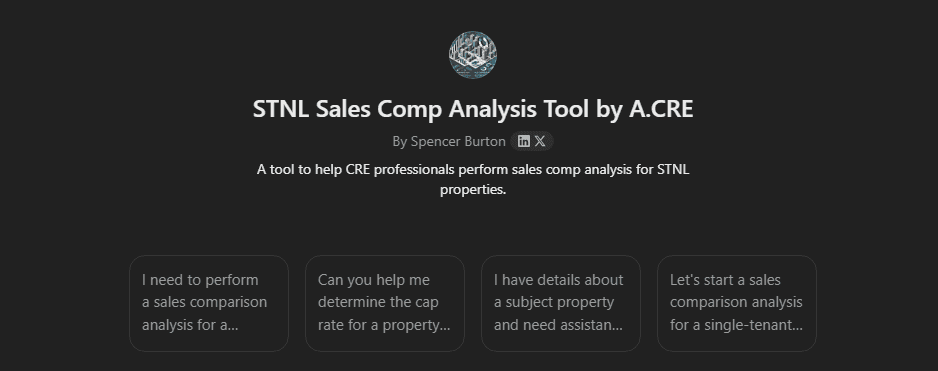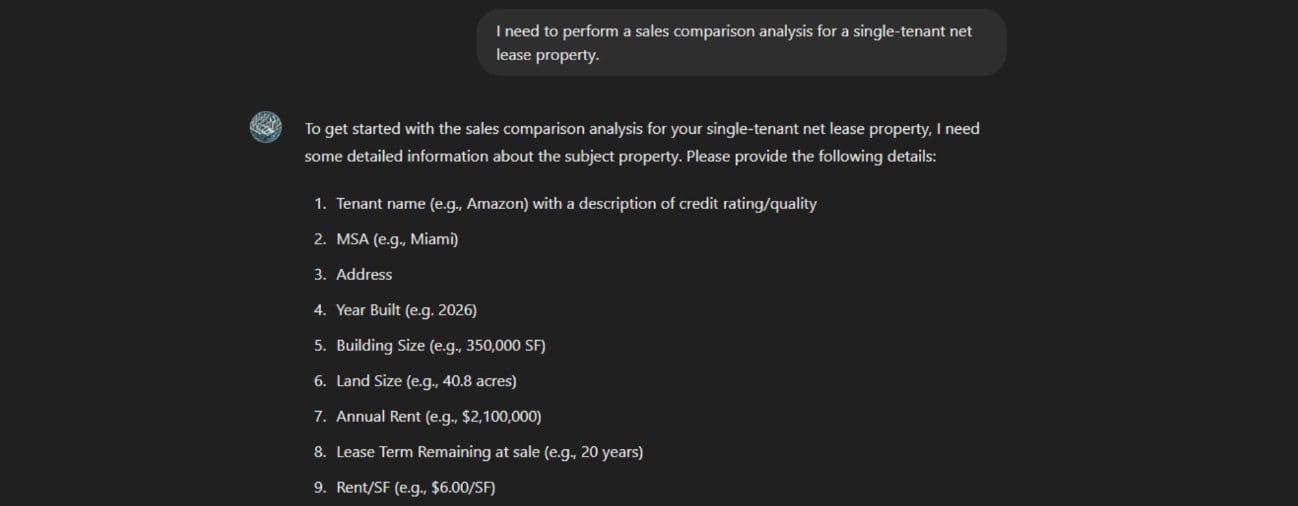STNL Sales Comp Analysis Tool – Custom GPT by A.CRE
At A.CRE, we’ve built dozens of custom GPTs for internal and external purposes. Some of the GPTs have general application, while others are custom GPTs specifically for commercial real estate. And among those custom GPTs specifically for CRE, we’re working to build the world’s largest library of real estate analyst GPTs.
A few months ago, we released our first real estate analyst GPT: an Advanced Mortgage Amortization Schedule custom GPT. And today, we’re excited to share our third real estate analyst GPT: our STNL Sales Comp Analysis Tool.
This GPT is trained to perform sales comparison analysis for single-tenant net lease properties by assessing and assigning proposed cap rates and expected values for subject properties based on detailed comparable sales analysis. In the coming months, we’ll continue to release other custom GPTs that will perform most of the financial modeling for the user in this same way.
- Note: Custom GPTs are now available to both paid and free users of ChatGPT (Click here to learn more).
Why we built the STNL Sales Comp Analysis Tool
We developed the STNL Sales Comp Analysis Tool as part of our ongoing effort to create a suite of real estate analyst GPTs, each designed to simplify complex tasks in the real estate analysis process. This tool, the third in our series, acts as a virtual analyst, guiding users through the process of performing sales comp analysis.
The primary function of this tool is to streamline and standardize the sales comp analysis process, making it faster and more consistent. To produce a consistent output comparable to the quality of a trained real estate analyst.
Additionally, the development of this tool, alongside the Advanced Mortgage Amortization Schedule GPT and the STNL Valuation Model GPT, served as a pilot project to explore the capabilities and limitations of GPT-4 in real estate applications. These early projects provided valuable insights, much like the iterative process I went through to perfect my first All-in-One model. Understanding the boundaries of current LLMs is crucial as we continue to innovate and push the limits of AI in real estate analysis.
Ultimately, our goals with this tool are fourfold: to standardize the sales comp analysis process, expedite the workflow, produce consistent outputs, and showcase the growing potential of AI in improving real estate analysis.
Access the STNL Sales Comp Analysis Tool
We developed this custom GPT as a service to A.CRE readers and the industry. As of May 2024, custom GPTs are available to both free and paid users of ChatGPT.
We regularly update the GPT (see version notes).
Click to chat with the STNL Sales Comp Analysis Tool and then use a simple prompt such as “Let’s start a sales comparison analysis” to get started. Note that as with all generative AI applications and Excel models, there may be output mistakes.
User’s Guide – STNL Sales Comp Analysis Tool
To use the STNL Sales Comp Analysis Tool effectively, follow these steps:
- Get Started. Enter a simple prompt to get started such as ‘Help me perform a sales comparison analysis for my STNL property’ or ‘Please assist in assessing a proposed cap rate for my subject property’.
- Provide Subject Property Details. Once you start the GPT, it will guide you through providing the details of the subject property, including:
- Tenant name with credit rating/quality
- MSA (Metropolitan Statistical Area)
- Address
- Year Built
- Building Size
- Land Size
- Annual Rent
- Lease Term Remaining at sale
- Rent/SF
- Provide Comparable Sales Data. Next, the GPT will ask for a list of comparable sales. You will need to provide the following key criteria for each comparable sale:
- Tenant/Credit Quality
- MSA
- Year Built
- Building Size
- Annual Rent
- Lease Term Remaining at sale
- Cap Rate
- Sale Price
- Sale Date
- Confirm Comparable Sales Data. The GPT will compile the comparables into a table and confirm with you that the information is correct. You can either request changes or confirm the data.
- Adjust Cap Rates. Based on your inputs, the GPT will make adjustments to the cap rates of the comparables to reflect the same characteristics as the subject property. It will share these adjustments for your review and confirmation.
- Weight Comparables. The GPT will assign weights to the comparables based on the importance of various factors and share the weighted analysis for your approval.
- Propose Cap Rate. Using the adjusted and weighted comparables, the GPT will propose a cap rate for the subject property and calculate the resulting expected value. It will seek your confirmation on the proposed cap rate.
- Produce Analysis Table. The GPT will generate an analysis table that includes all relevant data about the subject property and comparables, presenting a clear and organized comparison.
- Create Deliverable for Client. Finally, the GPT will produce a deliverable summarizing the sales comparison analysis, including a 2-3 paragraph summary and a comprehensive table of the comparables and subject property.
- Ask Questions and/or Report Bugs. If you have questions about any step or encounter issues, simply ask the GPT for clarification or assistance. If you find a bug, let it know and it will direct you to where you can report it.
Inputs You’ll Need to Provide the STNL Sales Comp Analysis Tool
To prepare for your conversation with the GPT, here is a summary of the inputs you’ll need to provide, broken out into the seven sections the GPT goes through. Note that you have the option to upload an offering memorandum (OM) to help populate some or all of these inputs.
1. Summary – Subject Property Description
This section covers basic information about the subject property, including the tenant name, address, city, state, Metropolitan Statistical Area (MSA), year built, building size, land size, annual rent, lease term remaining at sale, and rent per square foot. These details are crucial for understanding the fundamental characteristics of the property.
2. Summary – Comparable Sales Data
Here, you’ll input detailed information about the comparable sales, which are essential for the analysis. This includes the tenant name, credit quality, MSA, year built, building size, annual rent, lease term remaining at sale, cap rate, sale price, and sale date for each comparable property. These figures provide a basis for comparing the subject property to similar properties.
3. Inputs – Adjustments to Comparables
In this section, the GPT will guide you through making adjustments to the cap rates of the comparables to reflect the same characteristics as the subject property. This involves considering factors such as tenant credit quality, sale date, lease term remaining, building age, location quality, and annual rent differences.
4. Inputs – Weighing the Comparables
For this part, you will assign weights to the comparables based on the importance of various factors, such as tenant/credit quality, sale date, lease term remaining, building age, location quality, and annual rent. These weights will help determine the reliability of each comparable in the final analysis.
5. Inputs – Proposing a Cap Rate
Using the adjusted and weighted comparables, the GPT will help you propose a cap rate for the subject property. This section involves combining the weighted adjusted cap rates to derive a final cap rate range and selecting a proposed cap rate within this range. The expected value of the subject property will be calculated based on the proposed cap rate.
6. Inputs – Analysis Table
This section involves compiling all the relevant data into an analysis table. The table will include columns for tenant, MSA, address, year built, building size, cap rate, annual rent (NOI), sale price, price per square foot, sale date, and weight. The table will present a clear comparison between the subject property and the comparables.
7. Inputs – Creating Deliverable for Client
Finally, you will provide inputs for the deliverable summary. This includes a 2-3 paragraph description of the comparable properties, the analysis, and the ultimate conclusion (proposed cap rate and resulting expected value). The deliverable will also include a comprehensive table of the comparables and the subject property.
By preparing these summarized inputs, you can ensure a smooth and efficient process when using the STNL Sales Comp Analysis Tool GPT. If you have any questions about what to enter, simply ask the GPT for clarification.
Tips for Using Real Estate Analyst GPTs Such as this STNL Sales Comp Analysis Tool
As this is likely the first custom GPT of this type you’ve used, I thought I’d share a few tips I’ve found helpful when working with this type of AI.
- Treat the AI like your analyst: Engage with the AI as if it’s part of your real estate analyst team, expecting the same level of detail and engagement you would from a human analyst. Clearly communicate your needs and provide all necessary information.
- Upload Supporting Documents: If available, upload sales comps or other relevant documents to help the GPT. This can save time and improve accuracy.
- Ask for Clarification: If results aren’t clear or you’re unsure about any input or output, don’t hesitate to ask the AI for further explanation. It’s designed to help you understand the process and ensure the data is accurate.
- Be Explicit with Your Requests: Clearly articulate your needs and specific requirements. Precise questions yield precise answers. For example, specify exact dates, amounts, and rates to get the most accurate results.
- Double-Check the Outputs: Always verify the AI’s calculations/outputs against your own to ensure accuracy before making any financial decisions. This extra step ensures the reliability of the results.
- Report Bugs or Issues: If you encounter any bugs or issues with the tool, report them to us. This feedback helps us improve the tool and provide better service to all users.
- Stay Updated: Keep an eye on updates and new versions of the GPT. These updates often include improvements and new features that can enhance your analysis.
By following these tips, you can effectively use the STNL Sales Comp Analysis GPT (and other real estate analyst GPTs shared by A.CRE) to streamline your real estate valuation process, ensuring accuracy and efficiency.
Video Walkthrough – STNL Sales Comp Analysis Tool
To further help you get started using this custom GPT, below you’ll find a video walkthrough. The video guides you through how to use the GPT to conduct a comparative sales analysis. This video was built using v1 of the tool. We regularly update our Excel models and AI tools, and OpenAI is constantly updating ChatGPT. So, the version in the video may look different, but the base functionality remains the same.
Frequently Asked Questions about the STNL Sales Comp Analysis Tool GPT
Version Notes
v1.0
- Initial release












